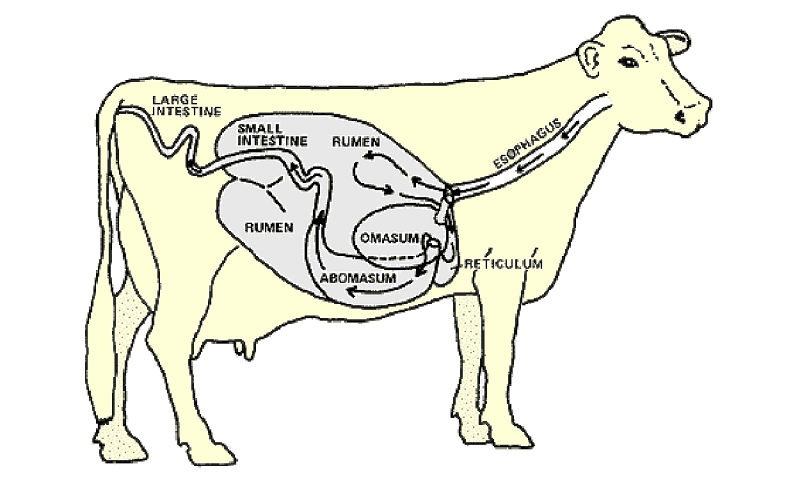Written by Madison Kovarna, former SDSU Extension Beef Nutrition Field Specialist.
Cattle are classified as ruminants. A ruminant is defined as an even-toed, hooved mammal that chews the cud regurgitated from its rumen. But why are they a big deal? Ruminants are important to our food chain, as they turn inedible forage sources into high-quality protein sources, such as meat and milk. Their powerhouse of a stomach is what gives them this superpower.
Stomach Compartments
A common misconception is that ruminants, such as cattle, have four stomachs. However, this is not entirely true. It should be said that ruminants have four specialized compartments within one stomach. The four compartments are the reticulum, rumen, omasum, and abomasum (Figure 1). Each of the four compartments serves a designated purpose for the success of the digestive tract. Additionally, each of these compartments have a differing texture to their tissue.

Reticulum
The reticulum does not have a clear separation from the rumen; thus, these two compartments often are called the reticulorumen. There is a small muscular fold between the reticulum and rumen, but it still allows digested feed to move unobstructed between the two compartments. The reticulum’s tissue has a honeycomb texture, which serves as “cups” to hold onto ingested feed. Cattle are indiscriminate eaters and often will swallow things they are not supposed to, such as screws, nails, bolts, and wire. These metal objects often find themselves in the reticulum and can cause hardware disease. This illness occurs when an object pierces through the reticulum wall where they can inflict damage on other organs such as the heart. To combat this, magnets can be placed into the animal’s reticulum to catch metal pieces before it occurs.
Rumen
The rumen is the largest compartment within cattle’s stomach, with a capacity of 25 to 50 gallons depending on the size of the animal. This is the compartment that makes these animals so unique. This section of the stomach is home to billions of microbes that allow for the digestion of feed products that humans cannot digest. Bacteria, protozoa, and fungi are common families of microbes found within the rumen fluid. Without these microbes, the ruminant animal would be unable to utilize forages (such as hay) for energy as efficiently. Microbes are responsible for digesting cellulose and complex starches while simultaneously producing proteins, B vitamins, and vitamin K. Fermentation is the method of digestion that occurs within the oxygen-deficient environment of the rumen. The rumen tissue looks and feels similar to a shag carpet, as the inner lining is covered with projections called papillae. These papillae allow for more surface area to increase nutrient absorption.
Omasum
As feed leaves the reticulorumen it moves into the omasum. Given the large amounts of water and rumen fluid that leave the rumen, it is important that the omasum comes next. The omasum is responsible for absorbing water from the ingesta. The omasal tissue has a series of folds covered in small papillae. This texture is why many people call the omasum the “butcher’s bible,” as the folds look like pages from a book when put together.
Abomasum
The abomasum is most similar to a human, or monogastric, stomach. This compartment is often referred to as the “true stomach,” as it contains hydrochloric acid and enzymes, much like our stomachs. This compartment prepares the nutrients for absorption by the small intestine. The tissue has smaller folds when compared to the omasum and is smooth and slippery. Mucus is secreted from the tissue’s surface to protect it from the acid produced, and this mucus is what gives the tissue a slippery feel.
Overall
Ruminant animals such as cattle are capable of digesting a variety of feedstuffs. The stomach of ruminants has evolved into a complex, four-compartment organ that allows cattle to survive off feeds, such as hay and corn silage. Further, microbes housed within the rumen give cattle the ability to utilize feedstuffs that humans and other simple-stomached animals are not able to digest efficiently. Therefore, it is important to understand the digestive system and the digestion process of ruminants so we can best support these unique animals.


